#the north western railway
Explore tagged Tumblr posts
Text
I really love the fact that so many of the engines on the NWR are weird one-offs or have some sort of strange origins.
On any other railway they really would not have lasted very long, but on Sodor, they have a home where they can show everyone just what they can do.
Talking more specifically about The Railway Series, this started unintentionally, it was just that the early NWR had no money and was desperate for any engines they could get. But It grows into just being a part of NWR culture, and how they value personality over practicality.
Like, the NWR keeping steam engines and even saving a few from scrap during modernization is really just an extension of this existing policy: they take in the engines no one else wants and give them a new chance at life. It's something which started with the Three Railway Engines and their stories, and leads all the way to Oliver.
Imagining some new cocksure engine on the NWR saying something like “I’m built different!” and then a more experienced Sudrian engine quickly correcting them bc literally everyone is.
“Welcome to Sodor, mate. We’re all built different. Gordon and James are experimentals, Thomas and Edward don’t even look like the bases they claim they were, fuck knows what Percy even is or where Henry came from, Diesel 10 has an attached hydraulic claw that is probably not approved…”
#reblog#ttte#rws#the north western railway#does this make any sense or am I just rambling?#The NWR and it's absolute mess of a locomotive fleet#Not to mention how so many of the diesels are also from weird and non-standard classes which BR no longer wanted
95 notes
·
View notes
Text

Cover of the menu at the dining car of the famous '400' (c. 1950s).
The '400' was an express train named for its scheduled 400-minute trip between Chicago and the Twin Cities, and was operated by the Chicago and North Western Railway (C&NW) from 1935 to 1963.
#vintage menu#1950s#dining#food#art deco#train#400#express train#chicago and north western railway#birds#herons#usa#trains
230 notes
·
View notes
Text
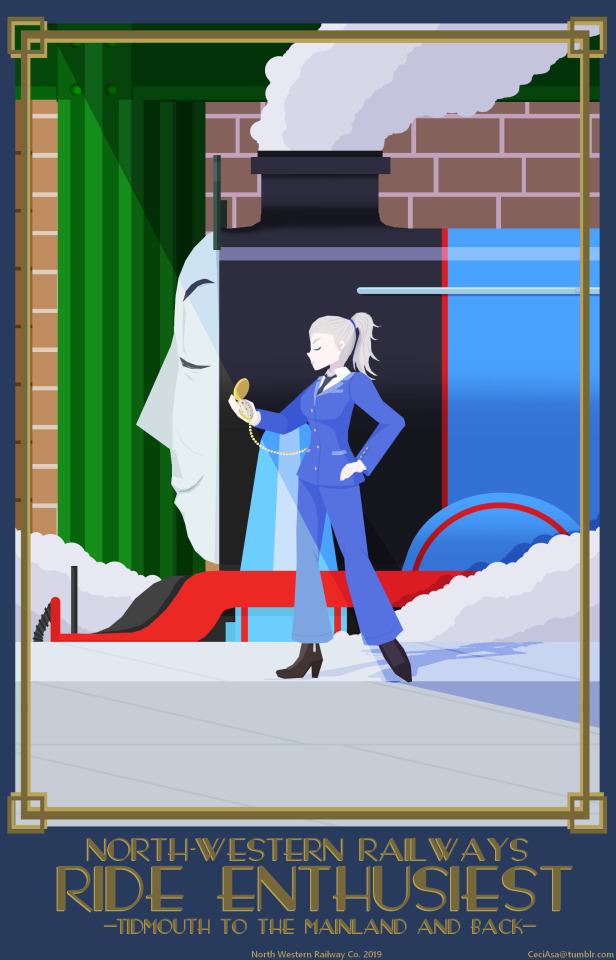
NWR Poster 1 - Enthusiast Run
Young Nor' Westers - Natasha Morozov
#art#ttte fanart#artists on tumblr#digital art#ttte#thomas and friends#ttte human oc#ttte gordon#North Western Railway Poster#art deco#railway poster#railways#the railway series#rws#thomas the tank engine#Young Nor' Westers
430 notes
·
View notes
Text

Swindon Gordon Has been remastered to use the updated LNER A1 Base.
#Hazel's Art#TTTE Gordon#Swindon Gordon#Great North Western AU#Great North Western Railway Au#GWR Palace Class#I'm sending you to Swindon#a fine place for sick engines
21 notes
·
View notes
Text







Temporarily out of service CSX main line.
This is the Clinchfield line in East Tennessee/Western North Carolina… or what’s left of it. There are now no major Highways or RR connections between Tennessee and North Carolina (per the Facebook post where I found these photos).
20 notes
·
View notes
Text
The Vicarstown Car Ferry

Above: This is not the Vicarstown car ferry train. I just needed a screenshot of a car on a train, and this was the closest I had to hand.
Every year, the Island of Sodor receives thousands of visitors from the Mainland, and obviously, the vast majority come by rail. A significant number, however, choose to arrive by car. Nowadays, this is no trouble, as they can simply drive across the Jubilee Bridge, which carries the main A950 road over the Walney Channel.
The bridge only opened in 1977, though, and any motorists arriving before then had to rely on the NWR's services to get themselves and their cars on and off of Sodor. And thereby hangs a fascinating tale about a little-known aspect of the NWR's history.
EARLY NWR EFFORTS
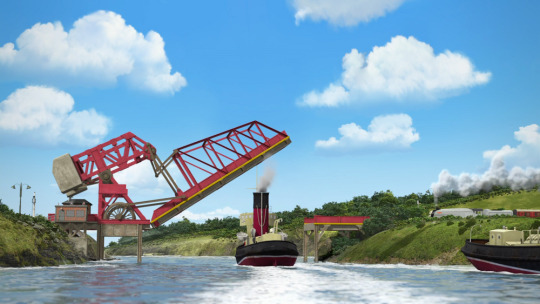
Above: The Vicarstown Bridge, in an undated view (obviously post-1975, given the presence of Spencer).
It all started with the construction of the NWR's own bridge over the Channel in 1915. In those days, there was no other link between Sodor and the Mainland, and thus no other way for goods and passengers to arrive. Some of those passengers wanted to bring their own horse-drawn carriages with them, and so was born one of the earliest vehicle-and-owner trains to run on Sodor. To begin with, it was simply a case of strapping the vehicle to a special carriage truck, and coupling it up to whatever passenger train its owner was travelling in. The truck then travelled as far as the nearest station to wherever the owner was going, where it was detached and the vehicle rolled off.

Above: For a time, the NWR also offered the use of a horsebox in conjunction with a carriage truck, so that the carriage’s owner could take his own horse with him, and avoid having to search for one at the other end of his journey. This cost extra, though, so there were few takers.
THE VICARSTOWN CAR FERRY
With the boom of private motoring in the early-1920s, there came a similar explosion in demand for the carriage of road vehicles by rail. This in turn resulted in the NWR running its first dedicated car-carrying trains - albeit only on an as-and-when basis, and with cars and drivers travelling in separate trains. The NWR did not return to vehicle-and-owner trains until 1927, when it launched a regular car ferry service between Vicarstown and Barrow-in-Furness - probably the best-known of all its car-carrying trains.
This new service had been made possible by the 1925 LMS Agreement, which gave the NWR running powers into Barrow, and in turn required Vicarstown to be converted for through running. Among the changes which resulted was the conversion of the adjoining goods depot to handle parcels and mail (goods facilities moving to a new depot elsewhere), and the closure of the existing parcels platform. This platform was thus free for conversion into a loading dock for the new car ferry service.
OPERATIONS
Throughout the fifty years the car ferry service ran, the basic pattern of its operation remained much the same, with only details like the motive power, rolling stock and timings seeing much change. It is thus worth looking at a typical journey for the service, starting at Vicarstown and ending at Barrow.
Below: A vague representation of how the loading process would have looked. I've employed a bit of artistic license with this photo: while the NWR did have some enclosed double-decker car carriers, these were never used on the car ferry services.

To begin with, the consist for that particular crossing was shunted into the station - the carriage trucks going to the loading dock, and the passenger coaches to one of the through platforms. Drivers and passengers boarded their coaches, leaving their cars to be loaded by the station staff. Once loading was completed, the carriage trucks were marshalled and coupled to the coaches. All shunting was done by the train engine, who then ran round to the front and hauled the train to Barrow. On arrival, the whole train was shunted to the loading dock there, where passengers and cars were unloaded together. The stock was then taken away for servicing. Of course, it goes without saying that in the opposite direction, the whole procedure was repeated, only in reverse.
In all, ten car ferry trains ran daily (five in each direction), with provisions in the working timetable for an extra four (two in each direction) if they were needed - say, during the busier summer months. To avoid overcrowding, a maximum of 20 cars were allowed on each crossing, and motorists had to book in advance. This enabled staff to work out how many carriage trucks were required, and what types, well ahead of time. It also allowed them to work out how many passenger coaches were needed - the rule here was that there should be at least one compartment for every car carried.
In the early 1930s, the NWR began allowing larger commercial vehicles to make use of the car ferry trains, and this required a slight amendment to the 20 cars rule. This amendment counted the size of a vehicle in car lengths - if, for example, a lorry turned up which was as long as three cars, then it took up three slots on that particular crossing. Any number of vehicles could thus travel on a single train, so long as their total length did not exceed 20 car lengths.
STOCK
The car ferry trains never had a specific engine allocated to run them - generally, any engine could do the job if they happened to be at Vicarstown or Barrow at the right time. As the NWR’s locomotive roster expanded, the car ferry became the exclusive preserve of the engines based at either of those sheds - the job generally being allocated to any engine who wasn't busy anywhere else that day.
The car ferry was also a neat way of getting an engine from one station to the other, without having to find an extra path for a light engine movement. For similar reasons, it was not uncommon for visiting LMS (later BR) engines to take charge of a Barrow-bound car ferry on their way home.
Below: An example of a long-wheelbase covered carriage truck. Many were later converted for parcels, newspapers or general goods traffic. This particular example went into departmental service, and in this view is carrying engine parts.

As far as rolling stock was concerned, this mainly consisted of both open and covered carriage trucks (henceforth referred to as OCTs and CCTs respectively). When the service first started, cars were carried on short-wheelbase OCTs, but these proved unpopular with motorists, as the cars often had their paintwork spoiled by smoke and soot spewing from passing engines - and sometimes from the engine pulling the train! The NWR tried to remedy this by offering the use of protective tarpaulins, but eventually they decided it would be more prudent to switch to CCTs instead.
Single cars were carried in short-wheelbase vans, similar in design to the GWR’s Mogo vans.
For pairs of cars, longer wheelbase CCTs could be used.
For trios or quartets, bogie CCTs were employed.
When larger commercial vehicles began to be carried, bogie OCTs were used - converted from the underframes of the fabled Dublin Stock.
Because of the aforementioned one compartment for every vehicle rule, the passenger coaches were at first quite a motley collection, with the numbers being made up by any old stock just lying around. It was only from the 1930s onwards that more consistent rakes of coaches began to be used - starting with Ironclad-pattern stock, moving on to Maunsell-pattern just after the War, and finishing up with Bulleid-pattern in the BR era.
MOTORAIL
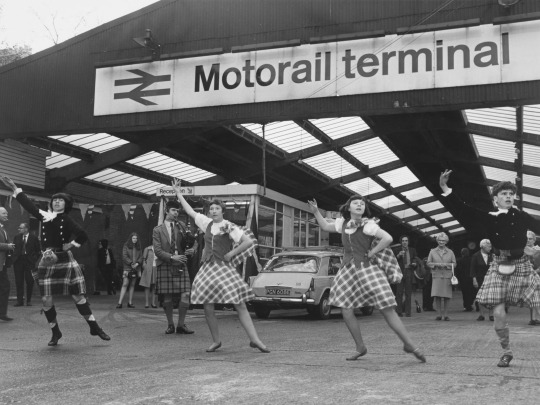
Above: A display of Scottish country dancing at...I think it's Kensington Olympia? No, I don't know why either.
In the 1960s, British Rail officially launched its Motorail service, offering fast travel for passengers and their cars to all parts of the country. To serve Sodor, one of the new services ran twice daily between Kensington Olympia and Vicarstown, and the latter’s existing loading dock was upgraded into a terminal. Two of the car ferry's ten daily crossings clashed with the proposed timings of the new Motorail services, and so were slashed from the timetable. Other than that, the car ferry was able to carry on as normal.
By then, the rolling stock used for the car ferry was beginning to show its age, and a programme of gradual replacement was implemented from about 1966 onwards:
For cars, General Utility Vans replaced the old bogie CCTs, which were retained for parcels traffic.
For commercial vehicles, Carflats replaced the OCTs, which were either scrapped or placed into departmental service.
Finally, for passengers, some of the NWR’s own allocation of BR Mk1s replaced the Bulleid-pattern stock.
The car ferry trains continued unabated into the 1970s, but it was clear they were running on borrowed time - for the first time, demand was beginning to outstrip capacity, and there was no room in the timetable to run extra trains. Then, exactly fifty years after the car ferries had first began, came a blow from which they were never to recover.
THE JUBILEE BRIDGE
That year saw the opening of the Walney Road Bridge, to mark the Silver Jubilee of Queen Elizabeth II. Needless to say, this snuffed out the NWR's car ferry monopoly in an instant. Nobody was more incensed at this development than Sir Topham Hatt, and he saw to it that the NWR was substantially compensated for the extinguishment of their ferry rights.
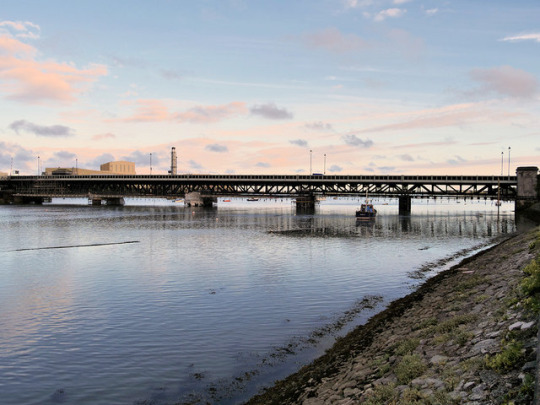
Above: The Jubilee Bridge. Visitors to Barrow (and native Barrovians, too) may think that this is the only bridge here. This is an illusion!
All was not totally lost, however, for 1977 also saw the extension of BR's existing London-Vicarstown Motorail service to a brand new terminal at Killdane - a more convenient base for the visiting motorist to explore Sodor. Such was the success of this new service that further others were introduced, linking Sodor with other provincial centres. Some of these services employed the stock which had previously worked the car ferry trains.
MODERN DAY MOTORAIL
The expansion of Sodor's Motorail services came during a period of gradual decline for the brand across the rest of BR. The expansion of Britain's motorways, the improvement of car technology, and the chaos of privatisation all ultimately conspired to kill off Motorail by the early-1990s.
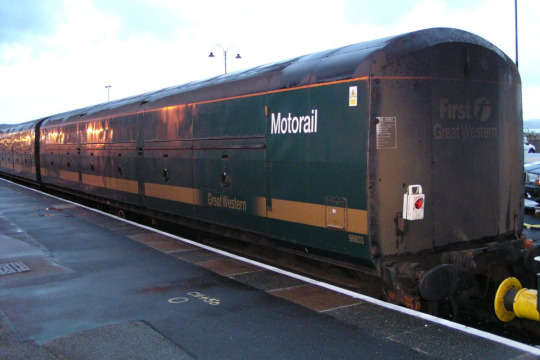
Above: First Great Western briefly revived the Motorail concept in the early-2000s, using a fleet of converted GUVs.
Despite this, Motorail on Sodor has continued to flourish into the present day. Not only are its existing terminals at Vicarstown and Killdane still in operation, but there is now a third terminal at Tidmouth. These form the basis for the NWR's current Motorail services, which all serve to help solve a very basic problem.
The thing is, many visitors to Sodor now arrive in their own cars, but the island's road transport infrastructure isn't really suited to the needs of the long-distance motorist. Fortunately, the NWR has them covered. Special car-carrying trains now run regularly between the Motorail terminals at Vicarstown, Killdane and Tidmouth. While you still have to book in advance, it's a small price to pay for having the convenience of a car at your disposal, without the insanity that comes from having to drive it all the way across Sodor.
Of course, while the NWR's Motorail trains are available to all motorists (local and foreign) the majority of their customers are Mainlanders - the typical Sudrian would just as soon leave his car at home altogether!
#thomas the tank engine#the railway series#sodor#island of sodor#ttte headcanon#ttte analysis#north western railway#vicarstown#vicarstown bridge#barrow in furness#car ferry
50 notes
·
View notes
Text

Here’s another profile pic of me. The hat is light blue and regular blue with the Union Pacific logo on it. The shirt vertically halved with sunburst yellow on one half and CNW green on the other half, with the Chicago & Northwestern logo on it. This setup references the historical fact that both Union Pacific and Chicago & Northwest jointly operated three streamliners; The City of Los Angeles, The City of Denver and The City of Portland. That is until October 1955 when CNW pulled out and the Milwaukee Road took over CNW’s operations on the streamliners in November 1955. This setup also references the fact that UP and CNW were long-time partners for many decades, all the way to the point where UP absorbed CNW in 1995.

This profile picture has a hat that’s white and green with the logo of the (USA) Southern Railway on it. The shirt in this profile pic is coal black with the shirt collar and outlines being N&W red with the Norfolk & Western logo on it. This setup references the railroad history fact that Norfolk & Western and Southern Railway were rivals back in the day and later merged into Norfolk Southern in June 1982.
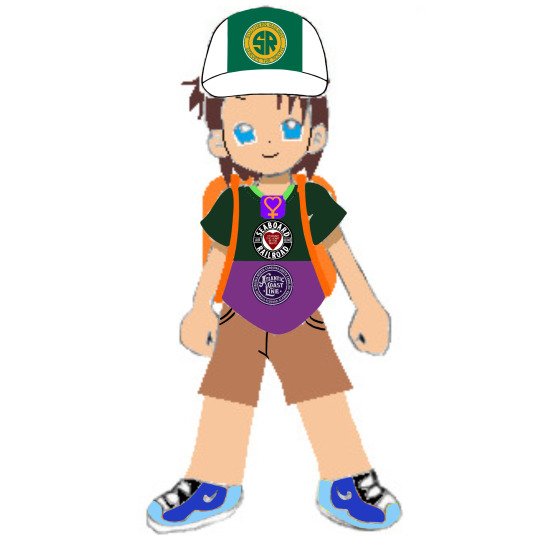
The hat is white and green with the (USA) Southern Railway logo on it. The top half of the shirt is dark green with the Seaboard Air Line logo on it while the bottom half of the shirt is royal purple with the Atlantic Coast Line logo on it. This setup is referencing the fact that prior to the late 1960s, the Southern Railway, Seaboard Air Line and Atlantic Coast Line were the 3 giant railroads in the southern United States.
#my oc character#my oc art#union pacific#chicago & north western#southern railway#norfolk and western#seaboard air line#atlantic coast line
8 notes
·
View notes
Text
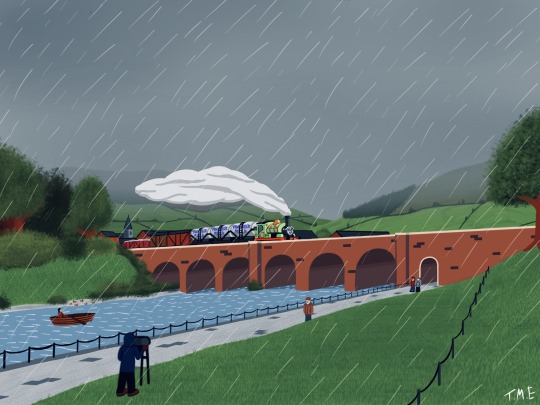
Typical British day for Percy.
#percy the small engine#ttte percy#thomas the tank engine#the railway series#thomas and friends#ttte au#the railway series au#the sudrians#ttte#elsbridge#island of sodor#north western railway
75 notes
·
View notes
Text
Lloyd the Crompton Diesel (My TTTE AU)

He is a good friend of Thomas, Percy, Toby, Daisy, Glynn and Mavis on the Ffarquar Branch Line (Meaning he is the only male diesel of this line) he is optimistic and clever at pulling passengers (But usually enjoys teasing Gordon the way Thomas does) but also loves hanging around with his other diesel mates on Sodor with Wendell and BoCo and he is also the NWR D10 diesel.
#thomas and friends#thomas the tank engine#Lloyd the Crompton Diesel#north western railway#island of sodor#Ffarquar Branch Line
9 notes
·
View notes
Text




For my first build of a Chicago & Northwestern locomotive, I went ahead and did the H-1 class 4-8-4. Over the main headlight is supposed to be the mars light, but couldn't make into an acutal light as it's the lower half of a blackstone slab ontop of the upper half of the blackstone slab. But that's just how Minecraft is so oh well.
#Minecraft#Minecraft Build#Minecraft Build Showcase#CNW#Chicago and North Western#Chicago & North Western Railway#Cheap and Nothing Wasted#H-1#4-8-4 Northern#Steam Locomotive#Trains
6 notes
·
View notes
Text
Random TTTE head canons and ideas No.1
Henry is a bit of a history buff and also likes to keep up with current events. When there is time his crew will read to him from the newspaper or a book about something he’s interested in. When he’s being prepared for the day or scrubbed down at night he’ll ask to listen to the radio. The only other engine that he can have really in depth conversations about such things is Edward (who gets most of his information from just talking to people).
Although the engines will give Henry a light ribbing for this interest they know it’s important to him and will turn to him for context and an understandable explanation when needed on such subjects.
Although not particularly interested in fiction he has a soft spot for mid century science fiction particularly Doctor Who novelizations. This has led to him calling rude mainland diesels “Daleks” from time to time.
In modern times his current driver has gotten a tablet and will occasionally show Henry videos and play audiobooks on the sort of things that interest him. Though Henry prefers to be read too because in his own words, “It’s just so much nicer to hear a familiar voice do it.”
Henry’s personal recommendations to other engines if they ever want to start being read to are: “ Heroes of History” by Winston Churchill, “The Daleks” by Terry Nations, and “Anything by The Thin Clergyman, of course!” He’ll say with a wink.
#ttte henry#the railway series#henry the green engine#thomas and friends#headcanon#bookworm#thomas the tank engine#ttte edward#just a thought#north western railway#the island of sodor#island of sodor#sodor
7 notes
·
View notes
Text

An LNWR Claughton passes beneath the "Birdcage" bridge at Rugby with a Euston-bound express, while a Great Central 9P passes above with a northbound express.
#trains#steam locomotive#LNWR Claughton class#GCR Lord Farringdon class#London & North Western Railway#Great Central Railway#Rugby#steam nostalgia
7 notes
·
View notes
Text

This year we're celebrating the 79th anniversary of The Railway Series by the Rev. W. Awdry. A series of books that not only connected many people in their childhood, but still does connect them even now that they're adults. My own love and passion for railways and especially steam locomotives wouldn't be the same without the series. Thank you Rev. W. Awdry for all the good memories, all the friends I've made through the series you brought to life.
My drawing from the book "The Eight Famous Engines" is part of the #rwscollab2024 and I am honoured to have taken part in it.
#thomas and friends#james the red engine#ttte#rws#the railway series#the eight famous engines#toby the tram engine#nwr#north western railway#steam locomotive#steam engine#railway#rev w awdry#anniversary#rwscollab2024#taf
6 notes
·
View notes
Text

NWR Poster 2 - Evening Passenger
Young Nor' Westers - Corelle Hemsworth
Speedpaint
#Young Nor' Westers#art#ttte fanart#artists on tumblr#digital art#ttte#thomas and friends#ttte human oc#North Western Railway Poster#art deco#railway poster#railways#the railway series#rws#thomas the tank engine#ttte henry
123 notes
·
View notes
Text

I asked permission to draw this two years ago...better late then never? At the end of Steam, BR had a number of unused A1 (peppercorn) spare boilers. They were scheduled to be scraped without ever being fired, but the North Western Region instead purchased them and refit a number of their aging 28 class (ROD 2-8-0) into 2-8-2 Mikados. Named the 28X class, these rebuilds boasted tractive efforts over 43,000lbs, an impressive upgrade from their original 31,325lbs.
#Hazel Art#NWR 28X Class#2-8-2#Mikado#ROD 2-8-0#LNER A1 Peppercorn Pacific#28X Class#NWR#North Western Railway
10 notes
·
View notes
Text


introducing the big four. the main troublemakers. berwyn (GWR) is probably the only one who still has this photo.
ask box is now open as well !
#inbetweenthelines#ibttl4#lner#lms#southern railway#gwr#great western railway#london midland scottish railway#london north eastern railway#ttte#the railway series#railway series#personification#gijinka#thomas the tank engine#thomas and friends#railway#british rail#oc art#digital art
42 notes
·
View notes